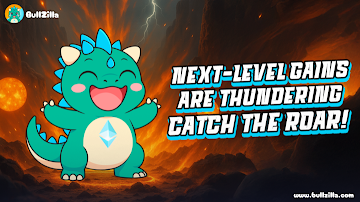Looking for Top Meme Coins to Buy This Month? Dogwifhat, PENGU, and BullZilla Top the Q4 Chart for 1000X ROI
Dogwifhat and Pudgy Penguins. These digital tokens have captured the hearts of meme enthusiasts, with both coins seeing significant interest due to their unique branding and community-driven goals. However, a new contender has recently emerged in the meme coin arena: BullZilla, one of the top meme coins to buy this month for Explosive Returns.
BullZilla, with its presale event currently ongoing, offers a fresh opportunity for investors and crypto enthusiasts alike. As the crypto world continues to expand, the surge of meme coins has captivated investors seeking high-return opportunities, and BullZilla ($BZIL) might just be the coin that pushes your portfolio to new heights. But what makes BullZilla different from Dogwifhat and Pudgy Penguins, and why should you consider investing in it right now?
BullZilla: The Top Meme Coins to Buy This Month with Explosive Potential
When looking for top meme coins to buy this month, BullZilla ($BZIL) is an investment opportunity that shouldn’t be overlooked. This Ethereum-based meme coin is currently in its presale phase, having raised over $920K with more than 3,000 token holders. BullZilla stands out not just for its community-driven approach but also its innovative features like the Roar Burn Mechanism and staking rewards, all backed by Ethereum’s robust blockchain.
With the presale in Stage 6 and a current price of $0.00015907, BullZilla presents a compelling investment case for those looking for explosive returns. As demand grows and the supply tightens through the burn mechanism, the potential for significant value appreciation is high. BullZilla has the momentum to break through in 2025, making it a must-watch in the meme coin market.
Investment Scenario: The Potential ROI of BullZilla ($BZIL)
Investing in BullZilla ($BZIL) at its presale stage presents a unique opportunity for high returns. Let’s break down the scenario for a $1,000 investment at the current presale price of $0.00015907.
With $1,000, you would acquire approximately 6.27 million $BZIL tokens. As BullZilla continues to gain traction and enters exchanges, the value of the token could significantly appreciate. Given the strong support from the Ethereum network and its deflationary mechanics, where tokens are regularly burned to reduce supply, early investors could see a substantial return if the token’s price increases by even a modest percentage.
Dogwifhat: A Meme Coin with Potential, But Risks Ahead
Dogwifhat is currently trading at $0.5488, which represents a 5.25% decrease in its 24-hour value. While the coin gained initial momentum, its future prospects are uncertain. Dogwifhat’s charm lies in its connection to the broader meme coin ecosystem, but its recent price drop indicates that it’s struggling to gain traction.
Dogwifhat was initially well-received due to its vibrant community and meme-centric branding. However, the lack of significant utility and a clear roadmap has left many investors skeptical. Without clear use cases or innovative features, Dogwifhat might not be able to replicate the success of BullZilla or other more well-established projects.
Pudgy Penguins: Meme Coin with a Strong Community, But Struggling with Market Momentum
At the moment, Pudgy Penguins is trading at $0.02357, a 4.07% decrease over the last 24 hours. The coin has experienced periods of significant hype, but its momentum seems to be waning. While Pudgy Penguins benefits from a loyal and passionate community, its price drop and lack of distinct technological features may prevent it from competing against newer projects like BullZilla.
What sets Pudgy Penguins apart is its cute branding and focus on building a strong community, which made it a popular meme coin. However, as the crypto space evolves, it’s becoming evident that Pudgy Penguins might not have the innovation needed to secure its place at the top.
Conclusion: Dogwifhat, Pudgy Penguins, and the Rise of BullZilla
Dogwifhat and Pudgy Penguins have faced challenges, but BullZilla stands out as a project with solid fundamentals and immense growth potential. If you’re looking for a meme coin with real value and long-term potential, BullZilla could be your best investment for 2025. Don’t miss the chance to be part of this exciting journey and secure your allocation in the presale today. As we’ve explored, top meme coins to buy this month like BullZilla ($BZIL), offer unique opportunities for investors looking to capitalize on the growing popularity of meme coins. With its strong Ethereum backing, innovative features like the Roar Burn Mechanism, and ongoing presale success, BullZilla is well-positioned to provide significant returns.
As the presale continues to raise funds and attract more token holders, now is the perfect time to get in before the coin hits the exchanges.
For More Information:
BZIL Official Website
Join BZIL Telegram Channel
Follow BZIL on X (Formerly Twitter)
Frequently Asked Questions for Top Meme Coins to Buy This Month
What is BullZilla ($BZIL)?
BullZilla is a meme coin built on the Ethereum blockchain, offering staking rewards, the Roar Burn Mechanism, and strong community backing.
How can I buy BullZilla coins?
Set up a Web3 wallet, buy Ethereum (ETH), visit the presale site, and swap ETH for $BZIL tokens.
What is the price of Dogwifhat currently?
Dogwifhat is currently trading at $0.5488, showing a 5.25% decrease in 24 hours.
What is the price of Pudgy Penguins currently?
Pudgy Penguins is currently priced at $0.02357, reflecting a 4.07% decrease in the last 24 hours.
Is BullZilla worth investing in?
With a strong presale performance, Ethereum-backed features, and great growth potential, BullZilla is a solid investment opportunity for 2025.
Glossary
- Web3 Wallet: A digital wallet used for interacting with blockchain-based applications and tokens.
- Ethereum Blockchain: A decentralized platform for building smart contracts and decentralized applications.
- Presale: A token sale event before a cryptocurrency’s official launch.
- Roar Burn Mechanism: A deflationary mechanism in which tokens are burned to reduce the supply, increasing scarcity.
ALT TEXT
Top meme coins to buy this month, BullZilla, Dogwifhat crypto, Pudgy Penguins crypto, BullZilla presale, $BZIL, meme coin market, Ethereum blockchain meme coin, crypto presale, meme coin investment, Dogwifhat price.
Summary
This article analyzes three meme coins: Dogwifhat, Pudgy Penguins, and BullZilla. While Dogwifhat and Pudgy Penguins have seen some decline in value, BullZilla ($BZIL) is rapidly gaining momentum with a robust presale and Ethereum-backed features. The article highlights BullZilla’s current stage in its presale, the potential for massive ROI, and its innovative features like the Roar Burn Mechanism and staking rewards. With over $910K raised and more than 3,000 token holders, BullZilla represents an exciting investment opportunity in 2025. The article also guides readers on how to buy $BZIL and discusses the growing potential of BullZilla in the meme coin market.
Disclaimer: This is a paid post and should not be treated as news/advice. LiveBitcoinNews is not responsible for any loss or damage resulting from the content, products, or services referenced in this press release.
The post Looking for Top Meme Coins to Buy This Month? Dogwifhat, PENGU, and BullZilla Top the Q4 Chart for 1000X ROI appeared first on Live Bitcoin News.
You May Also Like

Kraken Raises $500 Million at $15 Billion Valuation, Paving Way for Potential 2026 IPO

Why Investors Choose Pepeto As 2025’s Best Crypto: The Next Bitcoin Story
